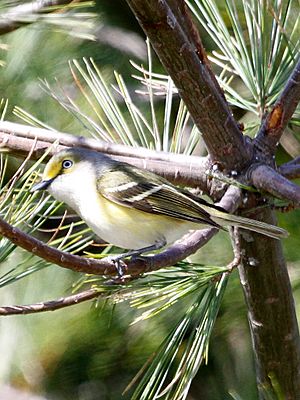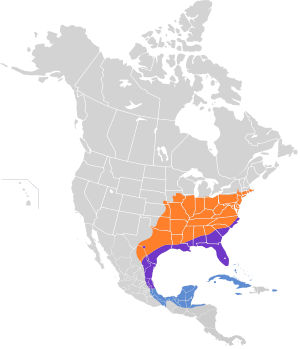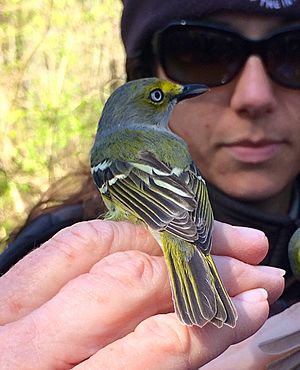White-eyed vireo facts for kids
Quick facts for kids White-eyed vireo |
|
|---|---|
 |
|
| Conservation status | |
| Scientific classification | |
| Genus: |
Vireo
|
| Species: |
griseus
|
 |
|
The white-eyed vireo (Vireo griseus) is a small songbird found in North and Central America. It gets its name from the bright white rings around its eyes.
These birds live in the southeastern United States, from New Jersey all the way to Texas and Florida. You can also find them in eastern Mexico, northern Central America, Cuba, and the Bahamas.
Some white-eyed vireos stay in warm areas like the Gulf Coast all year. But most birds that live further north fly south for the winter. This journey is called migration.
You can often spot these vireos in bushy areas, like old farms or overgrown fields. They like places with lots of shrubs and small trees.
Contents
Appearance and Features
The white-eyed vireo is a small bird. It measures about 4.3 to 5.1 inches (11 to 13 cm) long. It weighs about 0.3 to 0.5 ounces (10 to 14 grams). Its wingspan is around 6.7 inches (17 cm).
Its head and back are a greyish-olive color. Its belly is white, with yellow on its sides. The wings and tail are dark, and each wing has two white stripes. The most special feature is its white iris (the colored part of the eye), surrounded by yellow "spectacles." Male and female vireos look very similar.
Sounds and Song
The white-eyed vireo has a unique and fast song. It usually has six to seven notes. The song often starts and ends with a sharp "chick" sound. Each bird's song can be a little different.
Diet and Food
During the spring and summer, when they are raising their young, white-eyed vireos mostly eat insects. They especially like to eat caterpillars.
In the fall and winter, they add more foods to their diet. They still eat insects, but they also enjoy eating berries.
Life Cycle and Reproduction
White-eyed vireos build a neat, cup-shaped nest. They use grass and attach it to a tree branch with spider webs.
The female vireo lays 3 to 5 white eggs. These eggs have dark spots on them. Both the male and female birds take turns sitting on the eggs. This is called incubation. It takes about 12 to 16 days for the eggs to hatch.
After the chicks hatch, they stay in the nest for about 9 to 11 days. Then, they are ready to leave the nest and start exploring on their own.
Types of White-Eyed Vireos
Scientists recognize six different types, or subspecies, of the white-eyed vireo. They are:
- V. g. griseus – Found in central and eastern USA.
- V. g. maynardi – Lives in south Florida.
- V. g. bermudianus – Found only on Bermuda.
- V. g. micrus – Lives in south Texas and northeast Mexico.
- V. g. perquisitor – Found in eastern Mexico.
- V. g. marshalli – Lives in east-central Mexico.
The northern subspecies, V. g. noveboracensis, covers most of the white-eyed vireo's range. These birds are fully migratory, meaning they fly south for winter. They are also larger and have brighter colors than other subspecies.
The V. g. griseus subspecies lives along the southeastern coastal plain. These birds are a bit smaller and duller in color. They usually do not migrate far from their breeding areas.
The V. g. maynardi subspecies lives in the Florida Keys. It is greyer on top and whiter underneath. The V. g. micrus from south Texas is similar but smaller.
The V. g. bermudianus subspecies is special because it only lives on Bermuda. It has shorter wings and duller feathers. This subspecies faced threats in the 1940s when many Bermuda cedar trees were lost. It is now quite rare and protected by law in Bermuda.
Images for kids
See also
White-eyed Vireo species account at Neotropical Birds (Cornell Lab of Ornithology)  In Spanish: Vireo ojiblanco para niños
In Spanish: Vireo ojiblanco para niños





